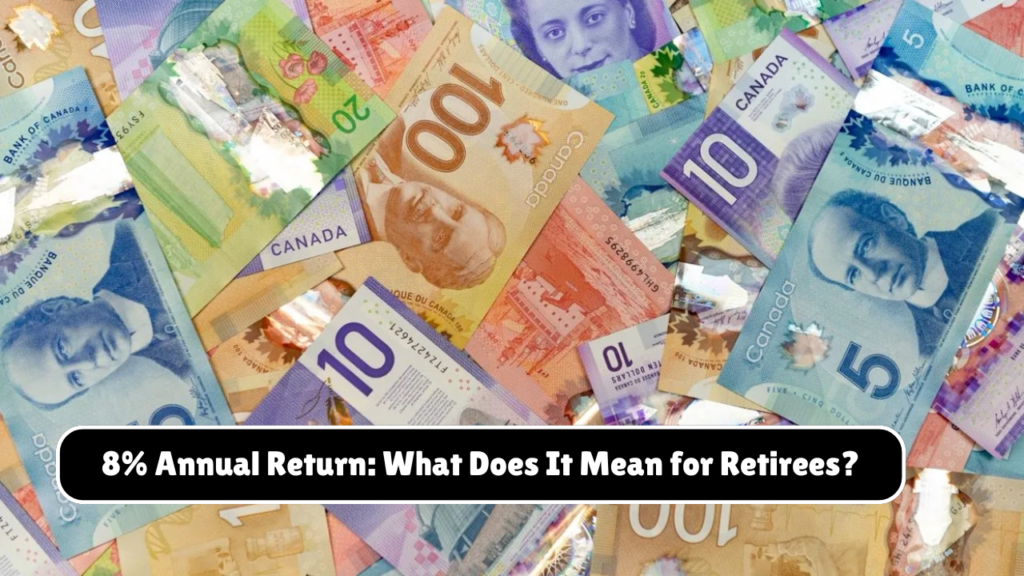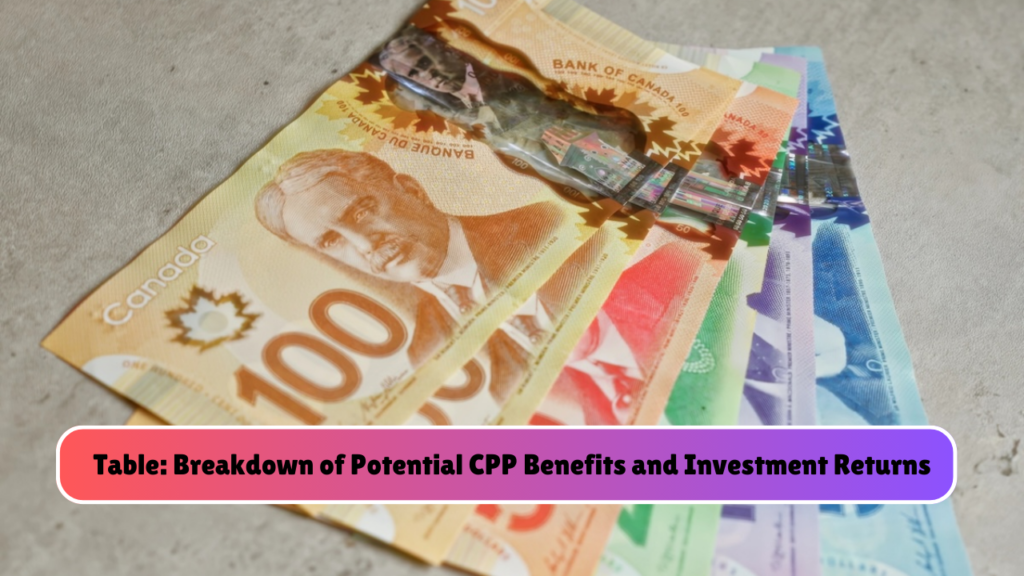The Canada Pension Plan (CPP) is a cornerstone of Canada’s social safety net for retirees, providing a monthly income to eligible Canadians who are 65 years of age or older, or who are disabled or survivors of contributors. The performance of the CPP Investment Board (CPPIB) has long been a point of discussion, especially regarding its ability to deliver sustainable returns that can keep pace with the needs of retirees.
In 2025, the CPPIB has reported an 8% annual return on investments, a figure that might seem promising at first glance. However, for retirees relying solely on the Canada Pension Plan for their post-retirement income, is an 8% annual return really enough to ensure financial security? This article will explore the implications of this return rate for retirees, including the sustainability of CPP benefits, how the return rate affects pension payouts, and whether this rate is sufficient to meet the retirement needs of Canadian seniors.
Understanding the Canada Pension Plan and Its Investment Strategy
The Canada Pension Plan (CPP) is funded by contributions from Canadian workers and their employers. These contributions are pooled into a fund that is invested by the Canada Pension Plan Investment Board (CPPIB). The goal of CPPIB is to grow the funds over time to ensure the long-term sustainability of the plan.
How Does the CPPIB Work?
- Funding Source: The CPP is primarily funded through payroll taxes, with contributions from both workers and employers. These contributions are matched and then invested by the CPPIB.
- Investment Strategy: The CPPIB is responsible for managing the funds to achieve the highest possible returns while managing risk. The portfolio is highly diversified, including a mix of Canadian and international equities, real estate, infrastructure, and other investments.
- Return Rate: The annual return on the CPPIB’s investments is an important indicator of how well the plan is performing. In recent years, the CPPIB has reported returns ranging from 5-8%, which is considered a solid performance in the context of global financial markets.

8% Annual Return: What Does It Mean for Retirees?
An 8% return on investments is often seen as a strong performance, especially in the context of low interest rates and volatile stock markets. However, for retirees depending on the CPP for their income, the significance of this return rate must be assessed in the context of their overall retirement savings.
1. The Role of CPP Benefits in Retirement
The Canada Pension Plan is not intended to be the sole source of income for retirees, but rather a supplementary income stream. The amount you receive from the CPP depends on how much you’ve contributed throughout your working life. While the CPP is designed to replace approximately 25% of your pre-retirement income (up to a maximum threshold), it is rarely enough to cover all living expenses for retirees, particularly those who were high earners during their careers.
- Average CPP Payment: As of 2025, the average monthly amount a single retiree receives from the CPP is approximately $1,200. However, this amount can vary depending on factors such as how long you worked and how much you contributed.
- Maximum CPP Payment: The maximum monthly payment for a single retiree at age 65 is approximately $1,200 – $1,400 (depending on when you start receiving the benefit).
Even with an 8% annual return on investments, the CPP’s overall performance won’t necessarily lead to significant increases in payouts for individual beneficiaries. While the fund is designed to grow over time, its primary function is to maintain the purchasing power of the plan, rather than offering large payouts or wealth accumulation for retirees.
2. The Impact of Inflation
One of the biggest challenges for retirees is inflation. Even a strong return like 8% annually may not be sufficient to combat the rising cost of living, especially in the face of higher healthcare expenses, housing costs, and inflationary pressures on daily goods and services.
In 2025, inflation in Canada is expected to stabilize at around 3-4%, which means that any growth in retirement income must outpace inflation in order to maintain purchasing power. While an 8% return is good relative to inflation, it may not be enough to compensate for the full increase in costs that many retirees face.
- Example: If a retiree’s living expenses increase by 3% per year, but their income only rises by 8%, the net benefit is just 5%. This might sound good, but it’s still not enough to fully safeguard retirees’ financial security in the long term.
3. Longevity Risk
With Canadians living longer than ever before, there is a significant concern about outliving retirement savings. An 8% return can help to ensure that the CPP fund remains viable for future generations of retirees, but individual retirees may still face the risk of not having enough to live on if they have little other savings beyond their CPP.
- Longevity Trends: The average life expectancy for Canadians is around 82 years, but many people live into their 90s. This means that seniors may need their retirement income to last for 30 years or more.
- CPP Sustainability: While an 8% return is an optimistic figure for the fund itself, individual payouts are designed to last a lifetime and adjust based on inflation, which could be problematic as costs increase faster than income in some cases.
4. Diversifying Retirement Income
It’s important to note that relying solely on the CPP is not advisable for most Canadians. While the CPP provides a foundation, it is recommended that individuals supplement their income with other retirement savings, such as Registered Retirement Savings Plans (RRSPs), Tax-Free Savings Accounts (TFSAs), and company pension plans.
Many retirees who have diversified their savings across multiple streams may find that an 8% annual return on the CPP investment fund plays a smaller role in their total retirement picture.

Table: Breakdown of Potential CPP Benefits and Investment Returns
| Age | Average CPP Monthly Payment | Estimated Annual Return on CPP Fund (2025) | Impact on Monthly Payout | Average Retirement Expenses (Annual) |
|---|---|---|---|---|
| 65 | $1,200 | 8% | No direct impact on payout | $24,000 – $36,000 |
| 70 | $1,400 | 8% | Slight increase in payouts | $25,000 – $40,000 |
| 75 | $1,400 | 8% | No increase, but stable | $28,000 – $45,000 |
| 80+ | $1,200 | 8% | Limited increase in income | $30,000 – $50,000 |
Note: These are approximate figures based on 2025 predictions and inflation assumptions.
Conclusion: Is 8% Enough for Retirees?
While an 8% return on the Canada Pension Plan’s investments is certainly a positive outcome, it does not necessarily translate to a significant boost in benefits for individual retirees. The CPP’s primary goal is to maintain sustainability and keep pace with inflation, but for many retirees, this return may still not be enough to meet their full retirement needs.
Canadians should view the CPP as just one piece of their overall retirement strategy, with other savings and income sources playing a crucial role in ensuring financial security. Furthermore, it’s important for individuals to be proactive in planning for their retirement by diversifying their investments, managing inflation risks, and saving for the long term.
FAQs
1. Will the 8% return on the CPP benefit lead to higher monthly payouts for seniors?
No, the 8% return on the CPP fund will not lead to a direct increase in monthly payouts for most seniors. The returns are used to maintain the fund’s sustainability and adjust for inflation.
2. How much can I expect from CPP in 2025 if I retire at 65?
The average monthly CPP payment for a single retiree in 2025 is approximately $1,200, though this can vary depending on individual contributions during your working years.
3. Can the 8% return from CPP investment protect against inflation?
The 8% return is positive in relation to inflation, but it may not be enough to fully protect retirees from rising living costs, especially in the case of high inflation or unexpected expenses.
4. Is the Canada Pension Plan enough for retirement in Canada?
While the CPP is an essential component of retirement income, it is rarely enough to cover all living expenses. It is recommended that Canadians also rely on personal savings, RRSPs, and other pension plans.
5. What should I do to prepare for retirement beyond the CPP?
It is important to diversify your retirement savings through RRSPs, TFSAs, and other investments, as well as considering private pensions or employer-based plans to supplement your CPP income.















